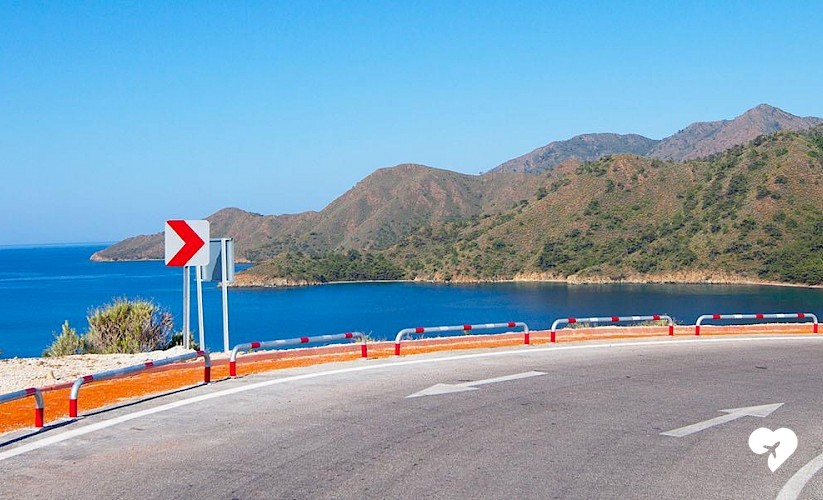The Datça Peninsula represents one of the most beautiful spots in Turkey, and likely anywhere on Earth. The peninsula is not wide at all, and often times you can see the Mediterranean on one side of you and the Aegean on the other.
The peninsula is also characterized by how remote it can feel. It’s less than an hour drive away from the busy holiday town of Marmaris, but once you’re out on the road it seems like you’re driving into the middle of an island in some far distant land. The water is pristine all around, but there are minor differences between the Mediterranean side of the peninsula and the Aegean.
So what’s the best way to discover them all? Let us take you on an amazing road trip before you go and do the real thing in person!
The must-sees on the Mediterranean side of the peninsula
İnbükü

This is a fantastic spot to pitch your tent and camp out for the evening, with organized camp grounds and spots where you can park your vehicle. There are showers, toilets, washing machines, electricity, a cafeteria, and more - though there are also nearby springs with fresh water that you can just fill up an empty water bottle for free and drink the most delicious water you'll ever have.
Kurucabük

Kurucabük is a sand beach that not a lot of people go to. There's a small pier for boats to berth and palm trees lining the whole coastline. Just behind the beach it's all forest, so head over here and breathe in the fresh air. This spot is secluded and the sea is calm, and it's easy to get to by car. A great find.
Aktur

Aktur is a more developed holiday spot, with camping grounds, cafes and restaurants. Because it's right on the open sea, the water is warm up through November, warmer even than in June because the water has warmed up all summer long. It doesn't get too humid and is a great place to sunbathe and relax.
Kargı Koyu

Kargı koyu (Crow Bay) is just outside the main town of Datça, and has gotten more and more popular in recent years. There are quite a few restaurants and cafes and it's got a nice beach covered with interesting pebbles for those who like to collect shells and stones. There's a stream that runs through it with ducks who live here, and nearby there are spots for amateur fishermen looking to catch their dinner.
Mesudiye

Mesudiye features some of the world's most breathtaking coves, including Hayıtbükü, Ovabükü and Kızılbük. There are plenty of facilities for holiday-makers here but it's still just a set of secluded coves surrounded by greenery. Most of the accommodation is family-owned guesthouses and apartments, with restaurants that serve local dishes, again often family-owned. The beaches are never crowded even in the worst of times, and the water is calm and wonderfully soothing.
Knidos
.jpg)
This ancient city is at the very tip of Datça. On one side is the Aegean and the other is the Mediterranean, and you can easily jump into the water and swim between the two as one of the city's ancient theaters looks out over you. This city was incredibly important, with many important names from ancient Greece originating here, including the Doctor Euryphon. The world's second largest medical school at the time was founded here by him, and the sundial that was invented by Eudoxus is still present today. Knidos had two theaters with a capacity of 20,000 people and 5,000 giving a sense of the size and scope of what this amazing ancient city used to be.
The must-sees of the Aegen
Değirmenbükü

Değirmenbükü features lovely coves and is the perfect place for a mid-afternoon picnic. It's about 4-5 kilometers away from the nearest village. People who either bike or walk the entire peninsula often pass by as the dirt road isn't ideal for low cars, and it's a nice spot to camp out for a night.
Mersincik

Mersincik Bay, located in the south of Gökova, is almost entirely sheltered from wind, making it a perfect place to camp out (and to swim in with an almost entire absence of waves as well). It's amazingly quiet and clean, and in the summer, sailors come and love to indulge in the cove's beauty. Sheep roam about nearby, and there are dirt roads leading to the local village of Cumalı.
Karaköy

The fertile soils of Karaköy produce all kinds of wonderful fruits and vegetables, with olives and almonds also produced. The almonds from Karaköy are considered to be some of the best in the world, and the town's stone homes and narrow roads make it truly an idyllic village. Walking out from the village forms a lovely hike and there are plenty of paths through untouched nature. There's a harbor from the village that goes all the way to Bodrum as well.
Hızırşah Village

Another idyllic village, this time surrounded by looming mountains and valleys growing wonderful almonds and olives. In ancient times this was an important center as there are lots of sources of fresh water running all down the mountain. The town features traditional architecture with a historic mosque and church, an ancient castle, and winding streets that are themselves pleasant to walk down.
End Trip with "Datça"
.jpg)
The Datça city center is the natural end point for your road trip. The town itself is quaint and also features a local outdoor theater in the mold of an ancient theater, where productions are held most evenings in the summer. The water is lovely and the town of old Datça features traditional stone houses, many of which sell souvenirs these days.
